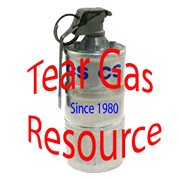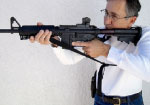“Emergency Gas” is a term we are hearing more often. What does it mean? I’ve talked with many agencies and there are many different definitions of “Emergency Gas”. Probably the best definition I have seen based upon many conversations with different agencies is; The immediate deployment of your non-lethal chemical agents or other law enforcement resources to life‐threatening situations where the delay in such deployment could result in death and/or great bodily harm to your team mates or other persons.
Each agency has a unique way of defining “Emergency Gas” and implementing their version. “Emergency Gas” by its name means you use it in an emergency. When you have team members moving up on a target and they encounter a suspect shooting at them from within the building non-lethal chemical agents can be helpful in distracting the suspect from his target and allowing for your teammates or others to seek cover. Hence, “Emergency Gas” is deployed to distract the suspect.
To make “Emergency Gas” a viable tactic all your personnel need to be outfitted with a non-lethal chemical agent and a quick way to deploy it. You must have a plan and train that plan. Always plan for the worst and hope for the best. This “Emergency Gas” tactic should be outside of the gas plan for the target. It should be a standard tactic that you can use during any deployment.

The primary objective of “Emergency Gas” is to distract a shooter and give your team mates time to seek appropriate cover. Since the agent may drive the shooter out your perimeter teams must be prepared to prevent escape and to take the suspect into custody.
Some items that you must consider when developing this tactic are:
- Who is going to make the call to deploy “Emergency Gas”? Options are a team leader or an individual officer facing the shooter. Varying circumstances may need both options available. If it is an individual and only he/she launches, how effective will it be, versus all the advancing perimeter team launching. The later would probably be more effective on a shooter and would need coordination at a team leader level.
- What is the command for “Emergency Gas” deployment? Something like “EMERGENCY-GAS-GAS-GAS”. Whatever the command it must be distinctive so it cannot be confused with other commands.
- If you have counter-snipers deployed and they can see the suspect aiming or shooting at a team member he/she should not hesitate to neutralize the suspect eliminating the need for “Emergency Gas”. Does that counter sniper need authorization to fire? It should be pre-discussed and decided upon tactic within the team. Snipers should engage and neutralize shooters if possible within the confines of the law.
- What agents and deployment methods will your team members carry? How often will they train on those agents and methods? It is not cheap to outfit and train each team member with the appropriate tools to deploy “Emergency Gas”. If you cannot do it right you should not try and implement the tactic.
- Directly after “Emergency Gas” is deployed your team members will need to don their respirators. You should practice this technique so all you team is not distracted from the suspect at the same time. Your team members must know that it is not an emergency to get their masks on. They must be able to work in gas environment. They can only learn this through training.
- Who else is present in the house? How will the tactic affect them.? How large is that concern versus protecting a team member? All food for thought as you prepare deploy.
- Once you have used “Emergency Gas” you will probable break out most of the windows in the structure. Your original gas plan may need to be revised. The structure will ventilate rapidly, even more so if you a stiff breeze blowing.
In summary, this is a tactic that most teams should have in their tool kit. But to make it a viable tactic you need to have the right equipment and train.





